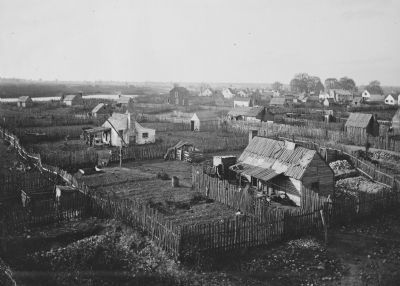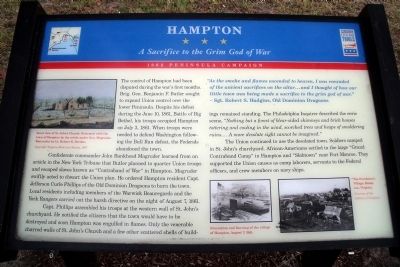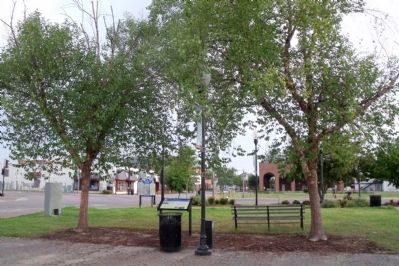Victoria Boulevard Historic District in Hampton, Virginia — The American South (Mid-Atlantic)
Hampton
A Sacrifice to the Grim God of War
— 1862 Peninsula Campaign —
Confederate commander John Bankhead Magruder learned from an article in the New York Tribune that Butler planned to quarter Union troops and escaped slaves known as “Contraband of War” in Hampton. Magruder swiftly acted to thwart the Union plan. He ordered Hampton resident Capt. Jefferson Curle Phillips of the Old Dominion Dragoons to burn the town. Local residents including members of the Warwick Beauregards and the York Rangers carried out the harsh directive On the night of August 7, 1861.
Capt. Phillips assembled his troops at the western wall of St. John’s churchyard. He notified the citizens that the town would have to be destroyed and soon Hampton was engulfed in flames. Only the venerable charred walls of St. John’s Church and a few other scattered shells of buildings remained standing. The Philadelphia Inquirer described the eerie scene, “Nothing but a forest of blear-sided chimneys and brick houses tottering and cooling in the wind, scorched trees and heaps of smoldering ruins…. A more desolate sight cannot be imagined.”
The Union continued to use the desolated town. Soldiers camped in St. John’s churchyard. African-Americans settled in the large “Grand Contraband Camp” in Hampton and “Slabtown” near Fort Monroe. They supported the Union causes as camp laborers, servants to the Federal officers, and crew members on navy ships.
(sidebar)
“As the smoke and flames ascended to heaven, I was reminded of the ancient sacrifices on the altar…and I thought of how our little town was being made a sacrifice to the grim god of war.” – Sgt. Robert S. Hudgins, Old Dominion Dragoons
Erected by Virginia Civil War Trails.
Topics and series. This historical marker is listed in these topic lists: African Americans • Notable Events • War, US Civil. In addition, it is included in the Virginia Civil War Trails series list. A significant historical month for this entry is June 1984.
Location. 37° 1.459′ N, 76° 20.612′ W. Marker is in Hampton, Virginia. It is in the Victoria Boulevard Historic District. Marker can be reached from the intersection of Settlers Landing Road (U.S. 60) and South King Street. This CWT Panel is located in Carousel Park. Touch for map. Marker is in this post office area: Hampton VA 23669, United States of America. Touch for directions.
Other nearby markers. At least 8 other markers are within walking distance of this marker. Dr. Katherine G. Johnson (a few steps from this marker); Langley Field: Discovering Aerospace (a few steps from this marker); Ninteenth-Century Hampton (a few steps from this marker); Langley Field: Creating an Air Force (a few steps from this marker); Eighteenth-Century Hampton (a few steps from this marker); Twentieth-Century Hampton (within shouting distance of this marker); Seventeenth-Century Hampton (within shouting distance of this marker); Dorothy Johnson Vaughan (within shouting distance of this marker). Touch for a list and map of all markers in Hampton.
More about this marker. On the upper left is an image carrying the caption, “Front view of St. John’s Church. Destroyed with the town of Hampton by the rebels under Gen. Magruder. Watercolor by Let. Robert K. Sneden. Copyright Virginia Historical Society, 1997
On the lower right are a sketch of the “Evacuation and Burning of the village of Hampton, August 7, 1861.” and a photo of “The Freedman’s Village, Hampton, Virginia.” Courtesy of the Library of Congress
Also see . . . Tidewater Virginia - The 1862 Peninsula Campaign

December 1864
3. Hampton, Virginia. Slab-town
Library of Congress Collection [LC-B815- 841 [P&P] LOT 4164-F]
Click for more information.
Click for more information.
Credits. This page was last revised on February 1, 2023. It was originally submitted on August 1, 2010, by Bernard Fisher of Richmond, Virginia. This page has been viewed 1,420 times since then and 18 times this year. Photos: 1, 2, 3. submitted on August 1, 2010, by Bernard Fisher of Richmond, Virginia.

